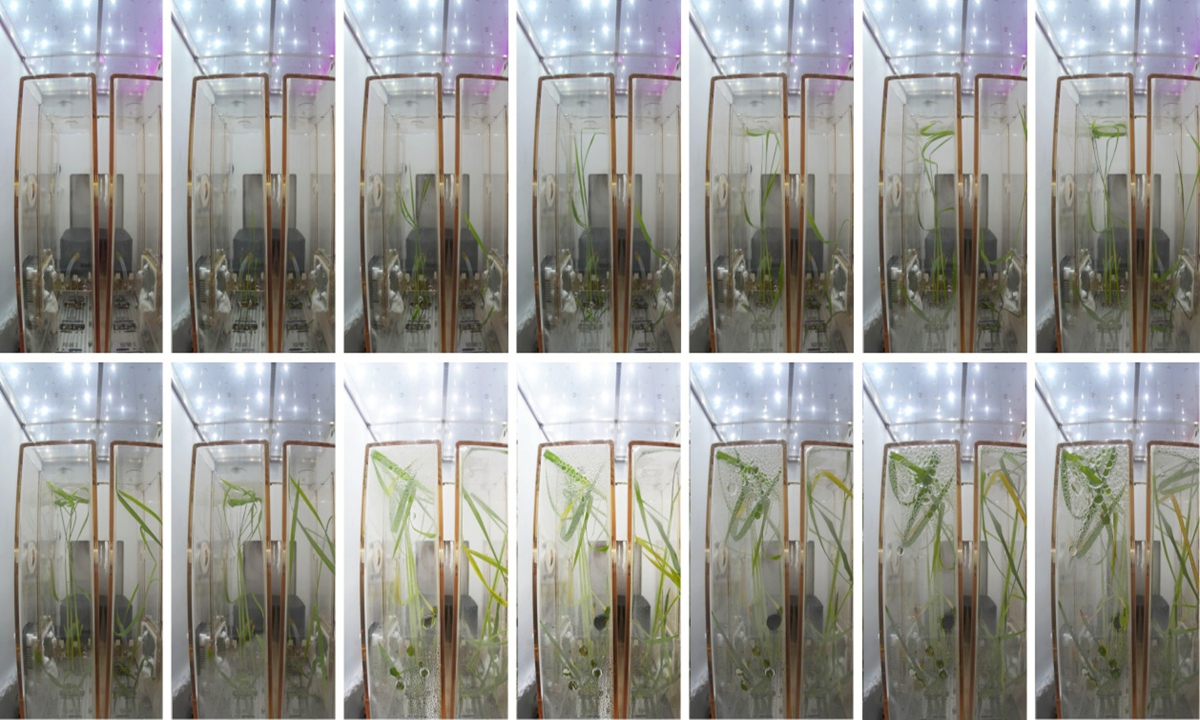
Growth and development of rice in microgravity Photo: Chinese Academy of Sciences
One month into the successful launch of China's giant lab module Wentian, it has brought some good news to research workers on the ground - the experimental seeds of thale cress and rice, which were brought into space together with the Wentian, have sprouted. The seedlings of thale cress have grown leaves, and the rice seedlings have grown some 30 centimeters high, the Global Times learned from the Chinese Academy of Sciences (CAS) on Monday.
The experimental unit containing the seeds was installed by taikonauts into the life ecology experimental module of the Wentian on July 28, and it was launched the next day through ground instructions.
Now the seeds are in good condition, with tall-grain rice seedlings having grown to about 30 centimeters high, and short-grain rice to 5-6 centimeters high, the Global Times learned from Zheng Huiqiong, a research fellow at the CAS Center for Excellence in Molecular Plant Sciences, also the team leader of the program, at a press conference on Monday.
Arabidopsis thaliana, or thale cress, is a winter annual with a relatively short lifecycle, and is a popular model organism in plant biology and genetics.
The reason why they chose thale cress and rice to conduct the experiment is that, Zheng noted, thale cress represents many kinds of vegetables, such as bok choy and oilseed rape, while rice represents many grain crops, such as wheat and corn.
"As the development of manned deep space exploration strides forward, even eyeing a future landing on Mars, it is impossible to rely solely on food brought from the Earth to meet long-term space travel needs, so the problem of growing food in space must be solved," Zheng said, noting that as life on Earth cannot survive unprotected in the harsh conditions of space, future space crop production must be carried out in a completely sealed-off artificial environment. Therefore, space-grown crops must meet the requirements of high yield and quality, high efficiency and low energy consumption.
The experiment is expected to complete a full life cycle "from seeds to seeds," and during the process taikonauts will collect samples and then freeze and preserve them, before finally returning them to the ground for analysis.
If completed, this will be the world's first to complete the whole life cycle of rice cultivation under space microgravity conditions. It will obtain key environmental parameters and provide important theoretical guidance for analysis of the impact of microgravity on rice growth as well as other space food production, observers said.
Over the past six decades, scientists around the world have conducted a great deal of research on growing and cultivating plants in space, having conducted more than 20 such experiments in various spacecraft. However, only a few crops, such as oilseed rape, wheat and peas, have been grown over their full life cycles in space environments.
On July 24, the giant heavy lift Long March-5B Y3 carrier rocket took off from the Wenchang Space Launch Site carrying China's first lab module for the space station and sent it into preset orbit.
Only three hours later, the space application system payload aboard Wentian was powered up for the first time and basic function tests were conducted. So far, the payloads are in good working condition, with initial settings and basic function tests returning normal readings.
During the Shenzhou-15 mission, in-cabin assembly and testing work of energy particle detectors and plasma in-situ imaging detectors will be performed on the Wentian. By the time of the Shenzhou-15's return, the in-orbit testing of all scientific experiment cabinets will be completed, and in-orbit experiments will be carried out subsequently, the Global Times learned from the press conference.
Having arrived at their space home for nearly three months, the Shenzhou-14 crew will conduct their first extravehicular activity in the near future, China Central Television reported.
They will, for the first time, venture out of the airlock cabin of the Wentian lab module, while their predecessors, the crews of the Shenzhou-13 and Shenzhou-12, all exited from the Tianhe core module.
The new airlock cabin is an "upgraded version" of the previous one in the Tianhe, expanding the "fitting room" for astronauts to change into space suits and prepare for their spacewalks, and a one-meter-diameter gate, enabling a more convenient exit and entry for the astronauts, while also allowing them to carry larger equipment outside the cabin.
Therefore, the airlock cabin of the Wentian will become the main exit-entry point for extravehicular activities, while the previous one in the Tianhe will serve as backup.
The last part of the three-module space station - the Mengtian lab module - will be delivered into orbit in October, space authorities previously revealed.
The Mengtian lab module was moved to the Wenchang Spacecraft Launch Site in South China's Hainan Province in early August, and has been assembled and undergone various function tests. China's space station will be constructed in a T-shaped basic structure, with the core module in the center and the two lab modules, Wentian and Mengtian, on either side of it.




